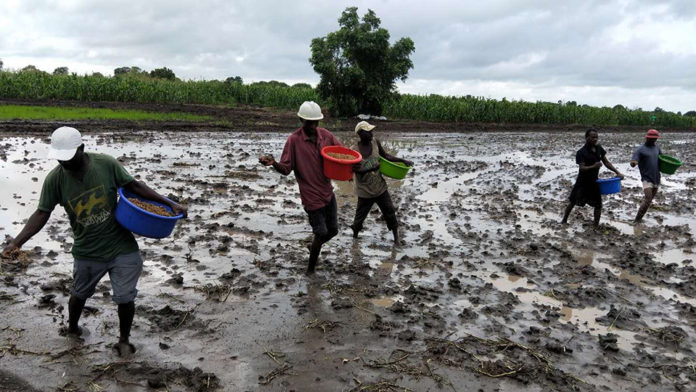Rice farmers in 85 cooperatives in Kanchibiya district in Zambia are geared to undertake the production of the cereal in the next farming season for domestic consumption and ensure food security.
The farmers, in collaboration with the Department of Agriculture in the District and local authorities have procured 255 x 20kg bags of rice seed and 344 bags of D-compound Fertiliser intended to cultivate one hectare each.
The Cooperatives are located in four wards along the Bangweulu Wetlands namely Chinama, Munikashi, Lulingila and Mbati Wards. They are expected to receive three 20 kilogram bags of rice each and four bags of D-compound.
Under phase one, 85 hectares of land will be cultivated, Kanchibiya lawmaker, Sunday Chanda says in a statement to FRA. The catalytic intervention is critical for sustainable development and social-economic development growth for Kanchibiya Constituency.
The project is phase one in our quest to uplift the economic well-being of Kanchibiya in line with Zambia’s economic transformation agenda anchored in the Vision 2030, 8th National Development Plan and the National Trade Policy, among others.
Early this year, the Ministry of Agriculture said it is implementing a Market-Oriented Rice Development Project (MOREDEP) with technical support from Japan International Cooperation Agency (JICA) in five agriculture camps in Mongu district, Western province.
The Market Oriented Rice Development Project is focusing on rice production using new techniques of good agricultural practices from growing up to harvesting of the crop, the Ministry of Agriculture is cited by Zambia News and Information Service (ZANIS).
Agriculture authorities had stated that the idea is to teach farmers how to produce quality marketable rice, the advantages of selling polished rice compared to unpolished rice, how to pack the crop and also access market information.
MOREDEP is also teaching farmers to have business plans for rice, as well as undertake simple businesses before the planting and after the harvesting season of the crop, in order to see if the business objective is being actualized.
MOREDEP had targeted 240 rice farmers in the five agriculture camps of Mongu district, namely Kaonde, Malanga, Katanga, Muskego and Namushakende and had empowered each one of them with a 10 kilogram bag of rice seed, line markers and ropes.
The three year MOREDEP was initiated in 2021 in Mongu, is expected to end in 2024 and the production for the last farming season has not yet been determined, adding that farmers are still at the harvesting stage of the rice grain.
Rice was identified as a priority diversification crop. The idea is to move away from the domination of maize in Zambia, according to a report in the Second National Rice Development Strategy.
“It is anticipated that crop diversification through rice production will contribute tremendously to enhancing the living standards of farm households,” the report read.
Zambia had until recently been pondering the growth of the rice growing sector. Stakeholders had identified several obstacles that still hampered Zambian rice production and exports, citing limited access to good quality and a variety of seed as the main concern. Market access and low levels of mechanisation along the whole value chain was another concern.
Nigeria has overtaken Egypt as the largest rice producer in Africa. Nigeria now produces 8 million tons out of the Africa average of 14.6 million tons of rice annually. Egypt used to produce 4.3 tons annually but suffered a decline of almost 40 percent in the last one year.









